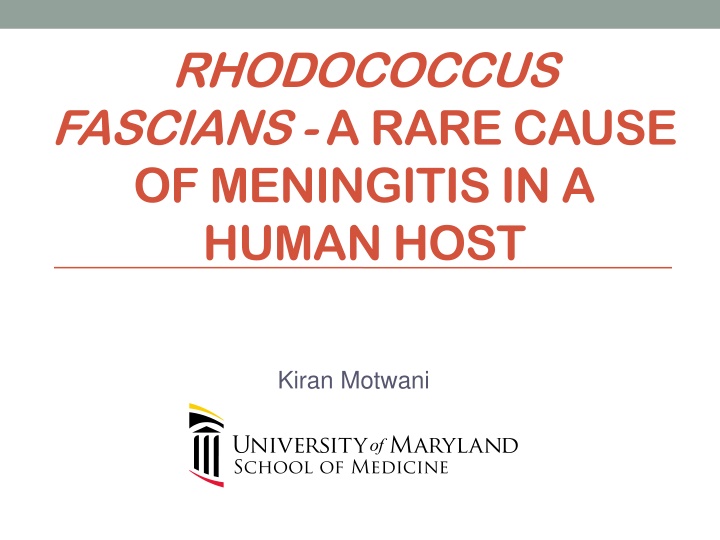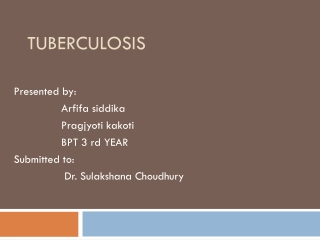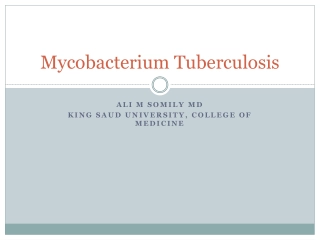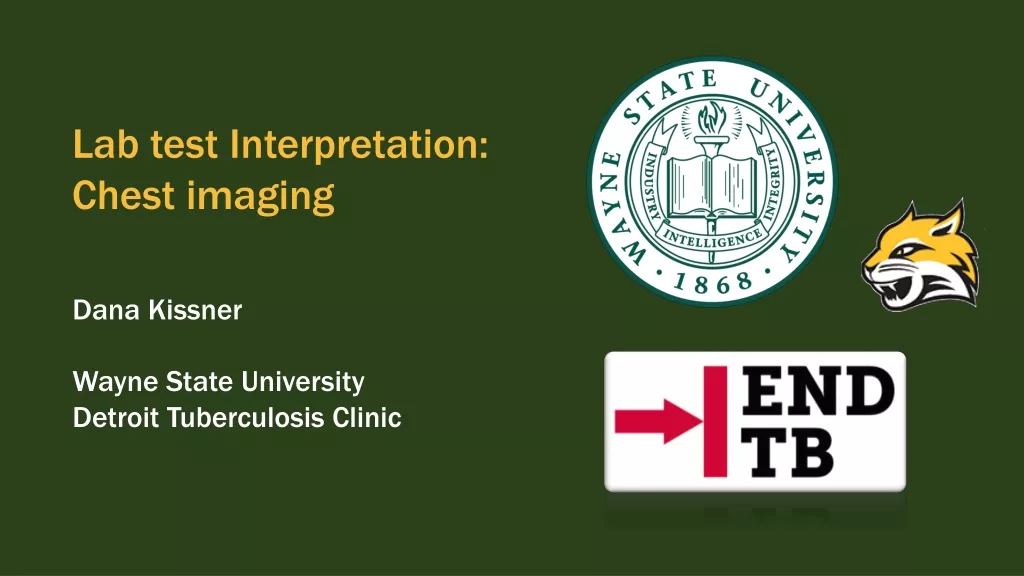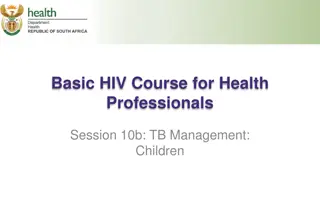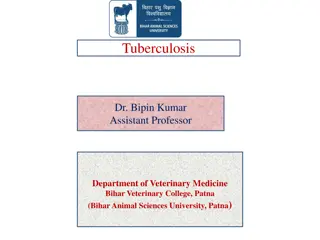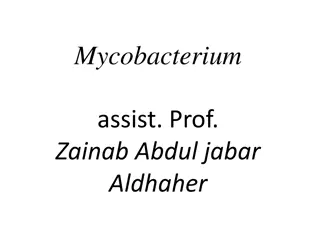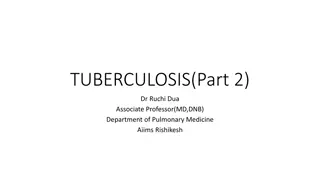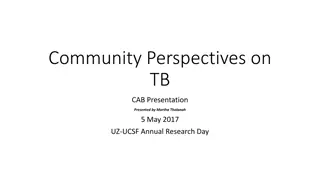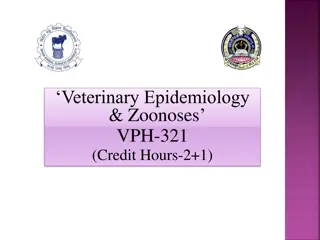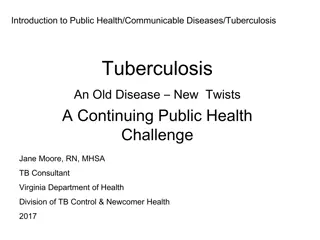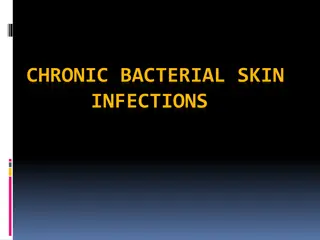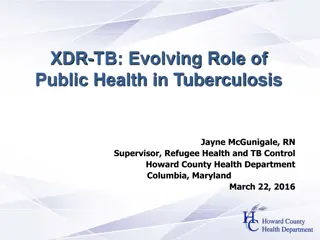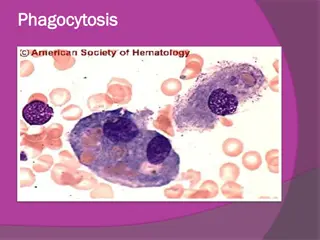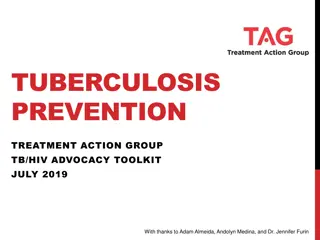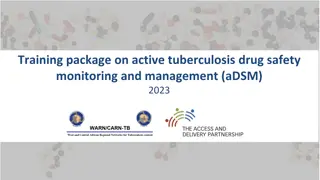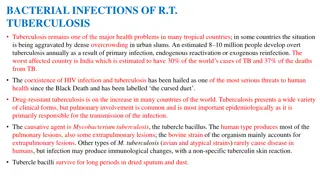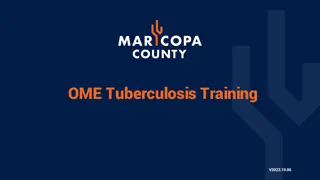Overview of Tuberculosis Presentation and Diagnosis
This content provides detailed information on the clinical presentation, signs, and diagnostic approaches for tuberculosis. It covers various sites of infection, symptoms, and presentations in pulmonary and extra-pulmonary tuberculosis cases. The images visually represent different aspects of TB diagnosis and presentation, including pulmonary consolidation, lymph node involvement, skeletal TB, CNS TB, and abdominal TB. Each section highlights key clinical scenarios, symptoms, and diagnostic methods for accurate identification and management of TB.
Download Presentation

Please find below an Image/Link to download the presentation.
The content on the website is provided AS IS for your information and personal use only. It may not be sold, licensed, or shared on other websites without obtaining consent from the author.If you encounter any issues during the download, it is possible that the publisher has removed the file from their server.
You are allowed to download the files provided on this website for personal or commercial use, subject to the condition that they are used lawfully. All files are the property of their respective owners.
The content on the website is provided AS IS for your information and personal use only. It may not be sold, licensed, or shared on other websites without obtaining consent from the author.
E N D
Presentation Transcript
RHODOCOCCUS FASCIANS- A RARE CAUSE OF MENINGITIS IN A HUMAN HOST Kiran Motwani
Introduction Rhodococcus species are obligate aerobes, gram-positive bacilli and partially acid-fast because of their mycolic acid- containing cell wall. They are isolated from a variety of sources including soil, ground water, plants and animals. The pathogenicity, however has been known to cause disease in immunocompromised hosts. microbe is generally considered to have low Transmission is by inhalation, ingestion or inoculation of the organism, usually from soil.
Patient Case 76 year old male Prior to hospitalization living in Dominican Republic. Admitted to a hospital there for dehydration, severe diarrhea, and weakness. Patient transferred to USA for further assessment. Admitted to an outside hospital for altered mental status - confusion, slurred speech, visual hallucinations and ambulatory dysfunction MRI brain - concerning for meningitis. Received empiric ceftriaxone & ampicillin. performed on initial evaluation. No lumbar puncture was
Patient Case 76 year old male Further work-up revealed a ruptured pseudoaneurysm of ascending aorta and hemorrhagic pericardial effusion Transferred to UMMC 48 hours later Underwent an aortic aneurysm repair with a graft placement. He remained however, 7 days post-operation improvement in his mental status despite antibiotics. hemodynamically stable; was there no
Patient Case - 76 year old male Past Medical History Hypertension Hyperlipidemia Alcohol Abuse History of prostate cancer (dx 1980) s/p brachytherapy & in remission Social History Used to live in South Carolina and previously an electrical engineer Moved to Dominican Republic for last 6 months prior to admission Heavy alcohol use for months Poor living conditions during Hurricane Maria with exposure to pigs in the home Medications Clonidine Nifedipine Triamterene-Hydrochlorothiazide Verapamil Atorvastatin
Physical Exam Vital Signs: T 35.9C, HR 96, BP 117/83, Weight 81.6 kg (180 lb) Constitutional: Chronically ill appearing HEENT: normocephalic, atraumatic. Nose normal. Dry oral mucosa. No oropharyngeal exudate. Conjunctiva clear, no scleral icterus or discharge. PERRLA. EOMI. Inability to flex neck CV: Normal rate, regular rhythm. Normal heart sounds. No murmurs/rubs/gallows. Intact distal pulses Pulmonary: Effort normal and breath sounds normal. Midline sternotomy surgical scar- healing well Abdominal: soft, bowel sounds normal. No distention or tenderness. No masses. PEG site clean, dry MSK: no edema or tenderness Neuro: Awake, alert, following simple commands. AAOx1 to self only. Dysarthric with unintelligible speech. 5/5 strength in upper and lower ext. normal sensation throughout. Skin: large stage IV sacral ulcer with visible underlying muscle. No surrounding erythema, fluctuance or drainage from site Psychiatric: cooperative. Affect normal
Imaging Mild widening of the ventricles reflecting volume loss versus a component of communicating hydrocephalus. Restricted diffusion associated with layering debris within the dependent portions of the posterior horns of the lateral ventricles with enhancement of the adjacent ependymal surface consistent with ventriculitis. Evidence of meningitis with enhancement of the leptomeninges in a patchy distribution most notable within the medial frontal lobes bilaterally and within the meninges and sulci of the frontotemporal regions bilaterally.
Laboratory Studies Bacterial culture: negative Cytology: negative for malignant cells Fungal Antibodies: negative for Aspergillus, Blastomyces, Coccidioides, Histoplasma, Cryptococcus Serology: negative for Bartonella, Coxiella, Brucella VDRL negative, Lyme Ab negative PCR negative for Enterovirus, HSV, CMV, VZV, EBV, HIV Quantiferon gold: negative; MTB PCR: negative, AFB stain negative ACE level in CNS: elevated ANA titer 1:160 Leptomeningeal Biopsy Pathology necrotizing granulomas with 16S rRNA gene sequencing positive for Rhodococcus fascians
Hospital Course Started on a 3-drug regimen with vancomycin, meropenem, and azithromycin for an 8-week course. Follow up MRI showed improvement in leptomeningeal enhancement and decreased ventricular enhancement. The patient s mental status and neurologic function improved however did not return quite to baseline. He was much more conversant, following commands and able to independently perform his activities of daily living, however he continued to have difficulty with short term and long term memory
Discussion Rhodococcus fascians is a rare cause of meningitis and not easily identified with routine microbial testing. Recognizing lack of improvement in disease course in an immunocompromised patient should lead providers to consider alternate pathologies and seek further testing with 16S rRNA gene sequencing. 16S rRNA gene sequencing provides genus identification in >90% of cases and species identification 65-83% of the time. 1-14% of isolates remain unidentified after testing. Treatment regimens are currently unknown due to the rarity of the disease. Vancomycin, rifampicin, quinolones, aminoglycosides, carbapenems, and macrolides are effective . A 2-3 drug regimen is recommended. Treatment courses can be 2-8 weeks and up to 6 total months.
References Austin MC, Hallstrand TS, Hoogestraat DR, et al. Rhodococcus fascians infection after haematopoietic cell transplantation: not just a plant pathogen?. JMM Case Rep. 2016; 3(2): 1-4. 1. DeMarais PL, Kocka FE. Rhodococcus meningitis in an immunocompetent host. Clin Infect Dis 1995; 20: 167-9. 2. Janda JM, Abbott SL. 16S rRNA gene sequencing for bacterial identification in the diagnostic laboratory: pluses, perils, and pitfalls. J Clin Microbiol 2007; 45: 2761-4. 3. Stutman RE, Reboli A. Rhodococci. Infect Dis Adv 2017. Retrieved Apr 27, 2019 from https://www.infectiousdiseaseadvisor.com/home/decision- support-in-medicine/infectious-diseases/rhodococci/ 4.
